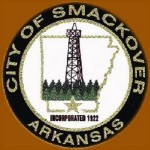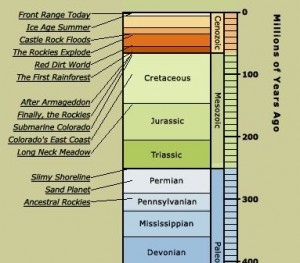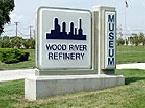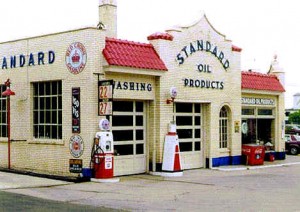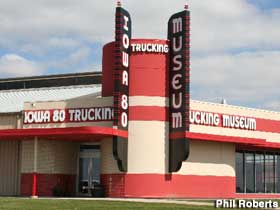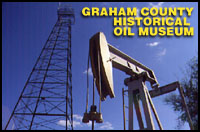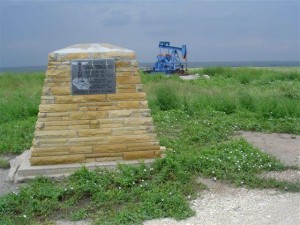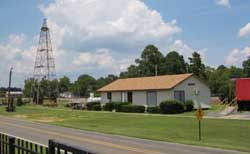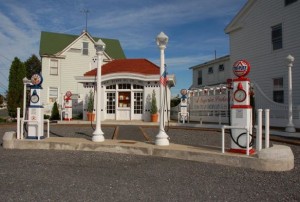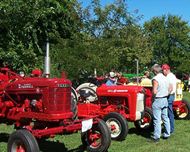Oil and gas museums are frontline energy educators.
Updated June 17, 2023
Community museums exhibit oilfield technologies, transportation, environmental issues, discoveries – and local pioneers who helped create the modern petroleum industry. The American Oil & Gas Historical (AOGHS) maintains an updated A-Z listing of these museums by state.
The AOGHS museum links often include related county historical societies. Separate pages are maintained for the large number of oil and gas museums found in California, Oklahoma, Pennsylvania, and Texas.

Thousands of students visit community oil and gas museums every year, including the Norman No. 1 Well Museum in Neodesha, Kansas. Photo by Timothy G. Wells.
Hundreds of museum volunteers (often retired geologists, petroleum engineers and other professionals) serve as front-line energy educators. They provide a first-hand understanding a complicated U.S. energy industry whose future requires an educated public. Museum visitors often walk away with a new appreciation of the earth sciences.
Further, museum visitors often are surprised to learn the role of petroleum products in modern society.
Although AOGHS regularly updates its museum links, the following state listings are far from complete. Let us know if your museum, county historical society or petroleum history organization would like to be included.
California Petroleum Museums
Automobile Driving Museum; Brea Museum and Heritage Center; California Oil Museum; Hathaway Ranch & Oil Museum; Kern County Museum; Olinda Oil Museum and Trail; Petersen Automotive Museum; R.C. Baker Memorial Museum; West Kern Oil Museum.
Oklahoma Petroleum Museums
Ames Astrobleme (Crater) Museum; Anadarko Basin Museum of Natural History; Bartlesville Area History Museum; Cherokee Strip Regional Heritage Center; Conoco Museum; Dobson Museum; Drumright Community Historical Museum; Frank Phillips Home; Greater Southwest Historical Museum; Healdton Oil Museum; Kerr Conference Center and Museum; Marland Oil Museum; National Route 66 & Transportation Museum; Nowata County Historical Museum; Oklahoma Historical Society and Oklahoma History Center; Oklahoma Route 66 Museum; Phillips Petroleum Company Museum; Sam Noble Oklahoma Museum of Natural History; Sarkeys Energy Center at University of Oklahoma; Stephens County Historical Museum; Triangle Heritage Museum; Tulsa Geoscience Center; Tulsa Historical Society; Woolaroc Museum.
Pennsylvania Petroleum Museums
Barbara Morgan Harvey Center for the Study of Oil Heritage; Coolspring Power Museum; Drake Well Museum and Park; Penn-Brad Oil Museum and Park; Petroleum History Institute; Pumping Jack Museum; Simpler Times Museum; Venango Museum of Art, Science and Industry.
Texas Petroleum Museums
Bertha Terry Cornwell Museum of Sour Lake History; Carson Country Square House Museum; Columbia Historical Museum; Depot Museum; East Texas Historical Association; East Texas Oil Museum; Felty Outdoor Oil Museum; Fort Worth Museum of Science and History; Gaston Museum; Harris County Historical Commission; Heritage Museum of Montgomery County; Houston Museum of Natural Science, Wiess Energy Hall; Humble Museum; Hutchinson County Historical Museum; Luling Oil Museum; Million Barrel Museum; Museum of the Plains; New London School Explosion Museum; Museum of North Texas History; Ocean Star Offshore Drilling Rig Museum; Oil Patch Museum; Panhandle-Plains Historical Museum; Perot Museum of Nature and Science; Petroleum Museum; Roaring Ranger Oil Boom Museum; Ranger Historical Preservation Society; Spindletop/Gladys City Boomtown Museum; Texas Energy Museum; Texas State Historical Association; Van Area Oil and Historical Museum.
Comments and suggestions are always welcomed. Is your museum not included? Contact AOGHS at bawells@aoghs.org
Alabama
Choctaw County Historical Museum
This small but notable museum features a collection of rare fossils, including the vertebrae from a giant whale that once swam in the prehistoric seas that covered Choctaw County. Visitors can see bottles of oil from Alabama’s first oil well, discovered in 1944 at Gilbertown.
The museum, on 40 Melvin Road, also is home to a complete Linotype “hot lead” letterpress newspaper print shop used to produce The Choctaw Advocate in the early years of this century. A one-room cabin, located on the west side of the museum, is constructed from logs dating back to the mid-1840s.
Alaska
Alaska Oil & Gas Historical Society
Committed to collecting and preserving artifacts, documents and photographs, the Alaska Oil & Gas Historical Society (AKOGHS) is a nonprofit organization dedicated to public education. Its mission includes preserving the role of petroleum “in shaping the state and its people and to preserve the legacy of those who have worked in the industry.”
AKOGHS hosts events and educational programs about Alaskan exploration and production. “Our plan is to develop archives that can serve as a valuable resource for researchers, students, and the general public, and to host exhibitions and to develop educational programs that provide a unique opportunity to the public to learn about the rich history of the industry.”
Reported in 2005 as the most remote of oil museum in America, the Gustavus Dray store and petroleum museum offered a pre-World War II replica Mobil service station with working 1937 “Wayne 60” gasoline pumps. The Alaska panhandle is where the first Alaska oil well was drilled at the beginning of the 20th century.
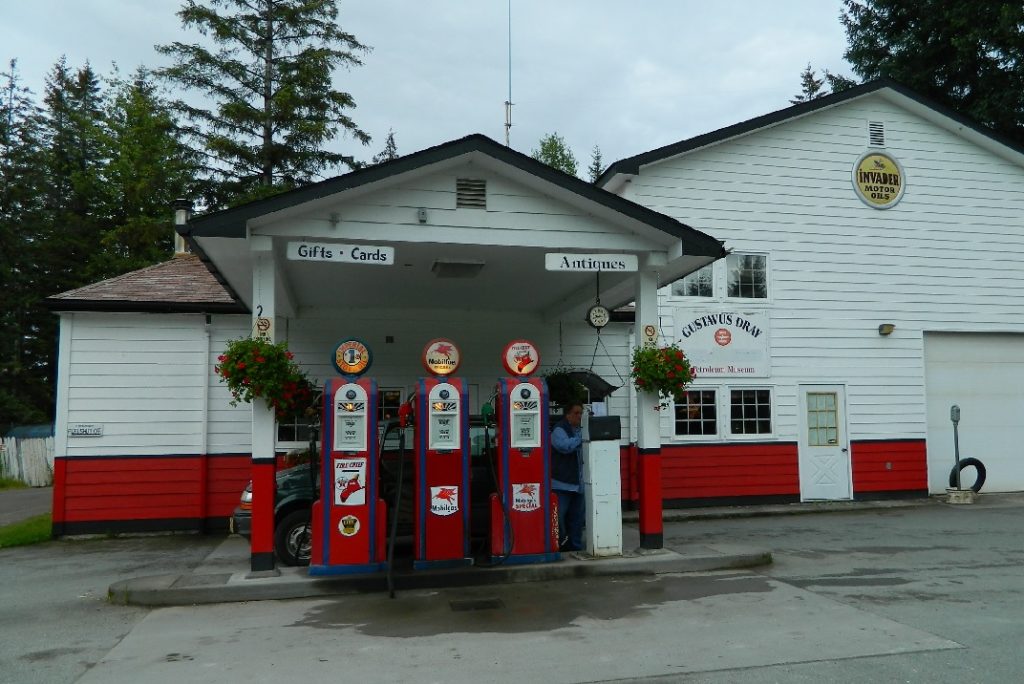
Gustavus is a gateway to Alaska’s Glacier Bay National Park. Photo courtesy Robert Blodgett.
According to Anchorage-based geologist and historian Robert B. Blodgett, visitors must travel by air or ferry to the site at the Glacier Bay National Park & Preserve. Cruise ships pass by, “but those folks do not get off in Gustavus, so have no access to seeing the museum.” Blodgett has authored a study of the Kenai Peninsula that includes the region’s oil drilling history. The the national park’s 3.3 million acres include glaciers, rainforest, and sheltered fjords as one of the world’s largest international protected areas, notes the the National Park Service.
The Classic Cars & Garage Museum at 184 Main Street in Trussville, Alabama, began as a 1950s Gulf service station where several residents worked “back in the day.” Among them was Trussville Mayor Gene Melton, who worked part-time between 1963 and 1966 while attending Hewitt Trussville High School.
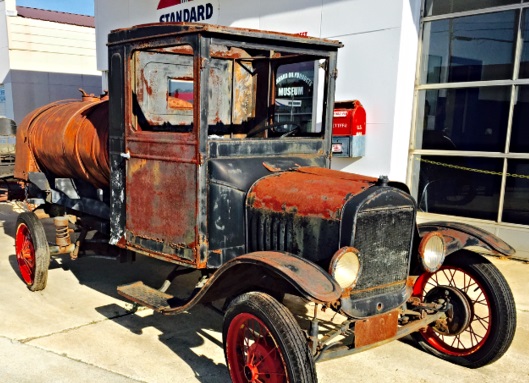
A 1925 Ford Model T Fuel Tanker at the Classic Cars & Garage Museum in Trussville, Alabama.
Founded by Rocky Neason, a 31-year veteran of the oil and gas industry, the nonprofit museum today preserves a circa 1960 “Standard Oil” gas station brand. The museum displays vintage automobiles, including a rare 1962 Corvette “Fuelie.”
“I enjoy the common interest from the museum visitors, allowing photo shoots that have included local high school senior portraits, recording artists and non-profit groups, as well as those who just wish to browse and bring back old memories,” Neason says. Classic Cars & Garage Museum hours are from 8 a.m. to 4 p.m., Monday – Thursday.
The website also notes that “most of the museum can be seen through windows at your own convenience.”
Arkansas
Arkansas Museum of Natural Resources
Officially opened to the public in 1986, the Arkansas Museum of Natural Resources is situated in the midst of the historic Smackover oilfield. The Busey No. 1 well near El Dorado “blew-in with a gusty fury” on January 10, 1921. The Arkansas Museum of Natural Resources, one mile south of the once oil-rich town of Smackover, is in the heart of the oilfield.
Surrounded by 20 acres of south Arkansas woodlands, the museum collects and exhibits oil – and brine – industrial history. It also documents a fascinating social history that accompanied the state’s oil boom of the 1920s.
Colorado
Denver Museum of Nature & Science
An “Ancient Denvers” permanent exhibit features the geology beneath the city: “From massive cliffs to jagged peaks to layer upon layer below the earth’s surface, rock formations hold tantalizing clues to hundreds of millions of years of geologic history along Colorado’s Front Range. These clues have revealed that over eons of time, the region has changed dramatically.”
Many clues to the region’s storied past were unearthed when the museum drilled a 2,256-foot-deep well through the rock layers beneath Kiowa, Colorado, in 1999. From that core, layers representing Colorado’s ancient landscapes were brought back to the surface.”
Florida
Don Garlits Museum of Drag Racing
“Enjoy the ride” staff say at of the Don Garlits Museum of Drag Racing in Ocala, just off Interstate 75. The private museum, which opened in 1976, includes almost 300 cars on exhibit in two main buildings. About 90 racing cars chronicle evolution of automotive technologies and the history of the sport of drag racing. Another 50 rare vehicles can be seen in the nearby antique car building.

Some consider museum founder Don Garlits the patriarch of Top Fuel Drag Racing.
Museum founder and CEO Don Garlits was the first drag racer to officially surpass the 170, 180, 200, 240, 250, and 270 miles per hour marks in the quarter-mile. Garlits says his museum’s mission is to preserve the history of drag racing and develop a national archive and library for educating the public “on the history and progress of all racing and presenting the uniqueness of this sport auto racing.”
The museum, which is home to the International Drag Racing Hall of Fame, also has many early gasoline pumps exhibited amid the high-performance cars. The Don Garlits Museum of Drag Racing is open daily from 9 a.m. to 5 p.m. (closed on Thanksgiving and Christmas). Standard admission is $20, although discounts are available.
Illinois
Illinois Oil Field Museum and Resource Center
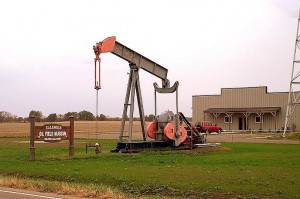
Oil in the Southern Illinois Oil Basin was discovered in the early 20th century. The Oblong museum, completed in 2001, preserves this little-known exploration heritage. Photo by Kris Wells.
“Money and volunteers, volunteers and money,” are the biggest challenges for the Illinois Oilfield Museum and Resource Center on the outskirts of Oblong, southeast of Effingham. The Illinois Oilfield Museum and Resource Center celebrates regional and state-wide oil heritage and history, as well and look toward the future interpreting state-of-the-art petroleum science education and related environmental sciences.
Outdoor exhibits include a pump jack and a 52-foot wooden derrick commemorating the well that launched Crawford County’s first oil boom. Oil in the Southern Illinois Oil Basin was discovered in the early 20th century — and brought great economic development to Illinois. Today, too few of the state’s residents are aware of the significant impact the industry has had over many decades.
Museum of Science and Industry, Petroleum Planet
Petroleum Planet, an exhibit at the Museum of Science and Industry in Chicago, explains: “Petroleum isn’t just a material – it’s a way of life.”
The Chicago museum’s oil exhibits emphasize a highly visual experience: “Greeted by a remote-operated underwater vehicle and multicolored tubes of bubbling crude oil, you’ll step into the exhibit as assume your role: a tiny hydrocarbon molecule in a vast pipeline. From there, you will embark on a journey through distillation and transportation control and the ‘pig pen,’ finally arriving at your destination as a finished product.”
The Wabash County Museum in Mt. Carmel is dedicated to preserving area history by presenting rotating exhibits about local industry – and oilfield worker families. “Oil has been important to the economy of Wabash County since 1912 when the first county well was drilled on the Lucy Courter lease,” the museum notes. “Oil had been discovered in Lawrence County, Illinois, and the same formations were producing in Wabash County. The discovery of oil at Griffin, Indiana, in 1938 led to an oil boom at Keensburg, in southern Wabash County in 1939.”
Wood River Refinery History Museum
“The museum is located in front of the refinery, in the area previously occupied by The Shell Research Laboratory and in the former Diagnostic Lab. “Step back in time at the Shell History Museum in Roxana, Illinois. Featuring over 1,000 artifacts and growing, the museum offers a visual review of the refinery’s many changes and significant progress from its groundbreaking in 1917 to the present.”
Exhibits, photo displays and a special videotape tell the story of how the legacy of Shell’s Wood River Refinery unfolded over three-quarters of a century. It is a story of extraordinary achievements and remarkable dedication on the part of thousands of Shell people. Today’s Wood River Manufacturing Complex is a premier refinery serving the vast Midwest market. Located along Route 111 in Roxana, Illinois the Shell History Museum is open Wednesdays and Thursdays except holidays. There is no admission charge.
Indiana
The Red Crown Mini-Museum is at the corner of 6th and South Streets in downtown Lafayette, Indiana, next to Tippecanoe County Library.
“The gas station was built by Standard Oil Company of Indiana in 1927-28 and had a one garage bay attached. It was built with glazed brick on all walls and red tile on the roof. In 1935-36 a second garage bay was added. It was in operation as a gas station until 1979, in 1985 the library bought the property for a future parking area. In 1991, Don Stein, a local business man and auto collector offered to restore the gas station and was finished later that year.”
Trumps’ Texaco Museum “offers a nostalgic trip to the 1950s, when US 40 bustled with cross-country travelers. The museum is housed in an old service station, which was once the location of Tydol Gas Station.” Harold Trump ran the station until 1941.
Iowa
The Iowa 80 Trucking Museum was a dream of Bill Moon, founder of the Iowa 80 Truckstop in Walcott, just west of Davenport – and “the world’s largest truckstop.”
Moon had a passion for collecting antique trucks and other trucking memorabilia. Each of his trucks has a unique story to tell about America’s trucking industry. Many are rare and even one-of-a-kind. Educational films are shown in the trucking museum’s theater. The museum encourages visits from schools. “It’s a great place for educators to enrich students’ learning,” notes the website. “Students can browse exhibits and view historic timelines to understand how trucking has changed over time.”
There are now more than 100 antique trucks in this Iowa museum’s collection. About 30 of these are usually on display — including a 1911 Walker Electric Model 43 that once delivered milk for Bowman Dairy of Chicago. In July 2011, the museum hosted a 100th birthday party for this rare electric truck.
Kansas
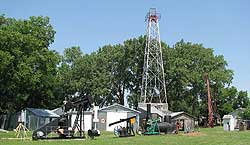
A large collection of drilling rigs — and a recreated boom town — are featured at the Butler County Historical Center and Kansas Oil Museum in El Dorado.
The Butler County Historical Center and Kansas Oil Museum in El Dorado has a large collection of artifacts from the first “scientifically discovered” oil wells, which drew the new petroleum geologists who were learning about anticlines and traps and ancient sea beds. Three million years ago the Mid-Continent was in the middle of an ocean.
The Kansas Oil Museum’s energy-education mission is to engage audiences of all ages in meaningful experiences by promoting interpretive programs and hands-on activities in an exciting, unique and entertaining atmosphere. Programs are age-appropriate and provide a unique learning experience by bringing history out of the text books and placing it in front of the student.
In northwestern Kansas, the Hill City Oil Museum is 12 miles east of Morland. Located beneath an oil derrick on west Highway 24 in Hill City, the oil museum – built in 1958 – tells the story of petroleum from deep producing formations. I
The museum is operated by the Graham County Historical Society, which meets at 103 East Cherry, across the street from the county courthouse, in Hill City — and where more exhibits include a military artifacts, vintage clothing, quilts, photos of early-day-Graham County.
Independence Historical Museum
The museum creates a sense of Kansas life from the 1800s when Independence was called “Hay Town,” to the present. The museum’s permanent exhibits in 22 rooms tell stories of the early settler lifestyles — and the history of the area’s oil industry.

A park in Independence, Kansas, has the Corythosaurus dinosaur from Sinclair’s “Dinoland” exhibit at the 1964 New York World’s Fair.
The museum documents the Pioneer, Sinclair and Arco oil companies. Displays include Sinclair and Arco advertising give-a-ways. Windows are from Hotel Chalmers, where oil companies had offices.
An old drafting table and drafting machine are exhibited, as are many artifacts and photographs. The museum, located in the Old Post Office Building at 8th and Myrtle streets, was placed on the State and National Register for Historic Sites in 1988.
Editor’s Note —The museum celebrates Sinclair’s Mid-Continent oilfield production and refining heritage. On display at a nearby Independence public park is Corythosaurus – one the surviving dinosaurs from Sinclair’s popular (10 million visitors) “Dinoland” exhibit at the 1964-65 New York World’s Fair. Learn more about Dinosaur Fever.
Kansas Oil and Gas Museum – Education Center
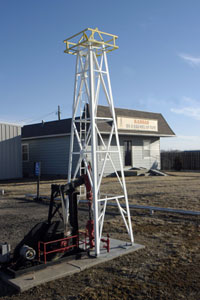
Independent oilmen founded this Great Bend, Kansas, museum. Photo by Bruce Wells.
Located on 10th Street in Great Bend, this museum — and energy education center — was founded in 1990 by a small but dedicated group of community volunteers interested in preserving the region’s significant petroleum heritage.
The main building of the museum preserves rare documents, newspapers and photographs, displays phases of the industry’s Kansas development, including geology, drilling, well completion, production, refining, and products. The building also houses a special Hall of Fame with biographies and pictures of inductees – including the museum’s founder, Danny Biggs (1936-2008), who was responsible for many of the educational exhibits.
Dedicated to his community, Biggs created and maintained unique scale models (popular with school children) and hundreds of artifacts that walk visitors through the evolving technologies of the petroleum industry.
As the museum website notes: “A tour of the Hall of Fame and Museum will teach you about the various phases of oil and gas production – from geology and drilling to production and product manufacturing.” Kansas Oil & Gas Museum, 5944 10th Street (PO Box 1294), Great Bend, KS 67530. (620) 793-8301
Miami County Historical Museum
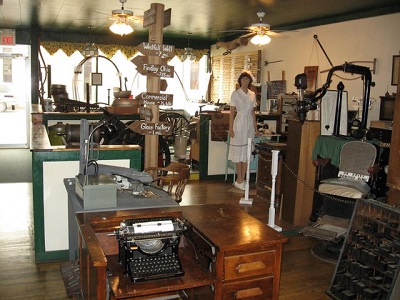
The Miami County Historical Museum is at 12 E. Peoria St. in Paola, Kansas.
When natural gas was discovered near Paola. Kansas, the Miami County community shined brightly. By March 1886, “Paola was lighted with Gas” when a pipeline was completed from the Westfall farm to the town square.
By the next year, natural gas “grand illumination” arches were constructed across the four corners of the square, explains the Miami County Historical Museum. “On June 28, 1887, Paola celebrated its first Natural Gas Jubilee.
“Excursion trains brought nearly 2,000 people to town to witness the wonders of natural gas by visiting the Boon gas wells just east of town, attending an auction of new town lots (and) feasting on a free lunch provided by the townspeople.”
Although the natural has boom did not last long, Paola annually celebrates its petroleum heritage.
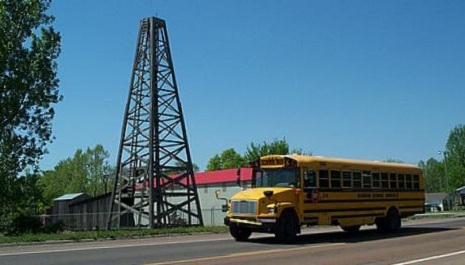
Students visit the Norman No. 1 Well Museum in Neodesha to learn about a 1892 Kansas gusher that launched their state’s petroleum industry. Photo by Timothy G. Wells.
In eastern Kansas, the Norman No. 1 Museum at Neodesha documents a November 28, 1892, discovery well – among the nation’s earliest.
The Kansas Historical Society says it is the first well to produce commercial quantities of oil west of the Mississippi River – and the first drilled in the vast Mid-Continent oilfield that covers parts of Kansas, Nebraska, Oklahoma, Arkansas, Louisiana, and Texas.
The Norman No. 1 Museum offers indoor and outdoor exhibits that include a replica wooden derrick located at First and Main streets in Neodesha. The Norman No. 1 well is a National Historic Landmark and listed on the National Register of Historic Places.
The Oil Patch Museum of the Russell County Historical Society exhibits Kansas petroleum heritage “that fuels man’s imagination as well as his machines — whether you are a youngster eager to explore a new subject or an experienced oil person looking to relive memories, you will catch the spirit of oil at the patch!”
The museum tells the story of the “Lucky Seven” and the drilling of Carrie Oswald No. 1, the 1923 discovery well in Russell County. Visitors can walk through an actual oil storage tank and study the geology, drilling and production and transportation exhibits.
The discovery of oil helped the entire northeastern Kansas region economically survive the Great Depression — and its impact is still felt today,” notes Dyrek Ayre of Hays. He has collected and restored historic photographs of the boom. Visit The Oswald Field. The Oil Patch Museum is located just north of Interstate 70 at the 184 exit.
Stevens County Gas & Historical Museum

The Stevens County Gas and Historical Museum complex includes the Santa Fe Train Depot in Hugoton, Kansas.
The Stevens County Gas and Historical Museum — established on May 16, 1961 — preserves the heritage of the giant Hugoton Gas natural gas field and the development of Stevens County in far southwestern Kansas. A natural gas well drilled there in 1945 is still producing.
Well equipment is on display and the main museum building houses exhibits of early 1900 furnishings. Restored buildings nearby include the Santa Fe Hugoton Train Depot, an 1887 school house, one of the oldest homes in Hugoton, and an early day grocery store and barber shop. There is a “professional building” — a tribute to Hugoton’s past judges and lawyer — and the first jail house in Hugoton. An agricultural building, completed in 1995, offers extensive displays of farm equipment and implements.
Louisiana
Louisiana State Oil and Gas Museum
Formerly known as Caddo-Pine Island Oil and Historical Museum, the Louisiana State Oil and Gas Museum in Oil City includes a 12,000-square-foot building near the community’s old railroad depot, donated by Kansas City Southern Railroad.
The museum is dedicated to the history and preservation of northwestern Louisiana’s natural resources, especially its rich oil history, including the nation’s earliest offshore wells drilled on nearby Caddo Lake.
Chevron donated the derrick and other oilfield equipment that help draw visitors to the museum, which is a 20-minute drive from Shreveport. Major exhibits include three historic boom town buildings — the depot, a bank, and a post office.
The museum is supported by state and the Caddo-Pine Island Oil and Historical Society, a nonprofit foundation dedicated to the preservation of the region’s oil and other historical treasures.
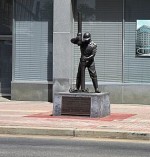
A statue in downtown Shreveport marks an 1870 well that provided the first known commercial use of natural gas in Louisiana.
Editor’s Note –The earliest manufacturing plant in Caddo Parish was in Gas Center outside Shreveport, where Purified Petroleum Products Co. of Louisiana patented a process for treating gasoline and kerosene. The earliest oil pipeline in the area was completed in 1910 by Standard Oil of Louisiana to its Baton Rouge refinery.
When in Shreveport, visit the Spring Street Historical Museum – and the nearby statue at 90 Market Street that commemorates an 1870 natural gas well.
The International Petroleum Museum and Exposition
In Morgan City, the International Petroleum Museum and Exposition is a non-profit corporation established for the purpose of educating the general public, and the next generation, on the significance of the offshore oil and gas industry and its affect on the local area, the state, the nation, and the world.
The offshore Mr. Charlie Rig Museum is on Front Street in Morgan City — located on the historic Atchafalaya waterfront. The center occupies one of the oldest buildings in the Historic District, the Goldman Building, circa 1910. From 1954 to 1986 Mr. Charlie drilled hundreds of offshore wells in the Gulf of Mexico — and was the first transportable, submersible drilling rig and an industry springboard to the current offshore rig technology.
Michigan
Henry Ford Museum & Benson Ford Research Center
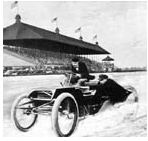
Henry Ford averages 91.37 mph in his Ford Arrow on January 12, 1904 — setting the world land speed record.
Located in Dearborn, the Henry Ford Henry Ford Museum and the Benson Ford Research Center include exhibits and a large selection of photographs, historical expertise and unparalleled collections documenting the “American Experience.”
The research center holds the Ford Motor Company Historical Archives from 1903-1955, as well as a nationally significant collection of business records, automotive product literature and periodicals, manuscripts, photographs, prints, postcards, maps, trade catalogs, and other library and special collection material.
The complex is an nonprofit educational institution not affiliated with the Ford Motor Company or the Ford Foundation.
New Mexico
The Farmington Museum on East Main Street features “Dinosaurs to Drill Bits” — an energy education exhibit that tells the oil and natural gas story of the prolific San Juan Basin.
“Using the latest in technology this exhibit educates and entertains visitors about an amazing resource we use everyday. Experience the thrill of riding deep into the earth in search of oil on a simulated floor shaking adventure.
Learn what it takes to drill thousands of feet looking for black gold. Then discover how it’s transformed into consumer products.”
New York
Pioneer Oil Museum of New York
The Pioneer Oil Museum of New York is located in the Village of Bolivar, Allegany County, in the heart of New York’s earliest producing area.

Exhibits at the museum in Bolivar, N.Y., include oilfield engines, maps, documents, pictures, models and tools. Wonderful Wizard of Oz author L. Frank Baum once owned an petroleum products company there – and sold oil cans.
In November 1865, Job Moses and his Hall Farm Petroleum Co. found oil in Carrollton Township, Cattaraugus County. The Moses No. 1 well was drilled to 1,165 feet and had initial production of only seven barrels per day – but the well was on the edge of what would become the giant Bradford oilfield.
Although dairying and livestock are an important parts of the local economy, the region still produces very high quality oil – and is now experience a natural gas boom thanks to horizontal drilling and production technologies for producing from the Marcellus Shale. Some geologists estimate the Marcellus formation could contain more than 500 trillion cubic feet of natural gas.
The Pioneer Oil Museum of New York mission statement: Believing that knowledge and understanding of the local oil and gas industries are vital to the heritage of this area, the museum will preserve the history and legacy of these businesses — and act as a repository for significant artifacts used throughout Allegany and Cattaraugus Counties.
H. P. Sears Oil Company, Inc., Service Station Museum
Born in Bombay, New York, in 1896, Howard P. Sears Sr. would begin his service station career selling oil as early automobiles became popular with consumers. He purchased his first gasoline delivery truck in 1923 and built his first bulk storage terminal near a railroad on South George Street in Rome, New York.
According to his son, Howard P. Sears Jr., in 1925 the H.P. Sears Oil Company was incorporated, By 1929 the elder Howard had built his first “new, modern gasoline filling station” in Utica. He would use the same basic design in 1930 for his second station (today’s museum) at George and Liberty streets in Rome. His third station was constructed in Ilion in 1933.
The Sears Service Station Museum is the only remaining station of the original design once in Utica and Ilion. On the walkway located each side of the building are a pair of restored Erie Clock face pumps, notes Howard Sears Jr., who dedicated the museum in 2006 — and accepted an award of merit from the Landmarks Society of Greater Utica. Visit the stations at 201 North George Street, Rome, New York.
Ohio
Allen County Museum & Historical Society
“Whether you’re an avid museum visitor, a serious historical researcher, or just looking for an enjoyable time out, the Allen County Museum has something for everyone” — and the museum’s Elizabeth M. MacDonell Memorial Library offers extensive information for genealogists.
On May 19, 1885, oil was discovered in Lima at near a paper mill along the Ottawa River. News spread and Lima became a boom town. The Allen County Historical Society’s Allen County Museum exhibits this local petroleum history. The oil well at the paper mill of Benjamin Faurot was never profitable — but it was started the area’s industry. The Lima oilfield was, for a time, the largest in the nation. The Ohio Oil Company was founded in 1887 by Henry M. Ernst in northwestern Ohio (see Marathon of Ohio Oil).
The Hancock Historical Museum in Findlay collects and exhibits artifacts that illustrate the county’s history — from prehistoric times through the present — with a unique emphasis on a natural gas boom that brought prosperity to the community. The Mae Huston Local History Resource Center is an archive and research facility that houses sources related to local history topics.
A private oil, gas, car and truck museum in Shreve, Ohio, the Ken Miller Supply Museum has grown to be among the largest U.S. collections of oilfield tools, machinery, and photos — with both indoor and outdoor displays that bring the nation’s petroleum past to life.
Founded in 1959, Ken Miller Supply, Inc. was owned and operated by Ken and Lois Miller. “The oil and gas business has been good to us, so I wanted to give something back,” explained Ken Miller. His love for history “served as motivating factors in the acquisition and preservation of a fabulous collection of oilfield antiques.”
Mercer County Historical Society
The Mercer County Historical Society collects and preserves artifacts, manuscripts, published materials, and records relating to county’s pre-history and history to increase public awareness and appreciation for Mercer County’s heritage. The Mercer County Historical Museum has hosted exhibits that include the history of Ohio Offshore Oil Wells, as well as the oil and natural gas booms in Mercer County and Midwestern Ohio, according to President Joyce L. Alig. histalig@bright.net
This group of collectors began with an idea for a club or social and fraternal society for people who like old oilfield engines. Members are known as “OAFS” — and as a policy there are no officers or lists of members. As a member, “you are free to use its name in any appropriate manner.”
Wood County Historical Center & Museum
An “Oil Boom” exhibit educates visitors to the Wood County Historical Center in Bowling Green. The center is located on the site of what was once the Wood County Infirmary, a large brick building that served as a home to the county’s poor, sick, orphaned, elderly, and mentally ill for over 100 years.
The first natural gas discovered in Wood County was found on the infirmary grounds in 1884 — and provided the natural gas that helped heat and light the home for many years. Today, a demonstration well pumps colored water that is channeled into two storage tanks.
The exhibit includes a derrick, steam boiler, an 1880s gas engine from Acme Sucker Rod Company of Toledo, Ohio, gear works from the AB Company in Findlay, and shackle rods that connect the pump jacks.
Pennsylvania Petroleum Museums
West Virginia
Oil and Gas Museum, Parkersburg
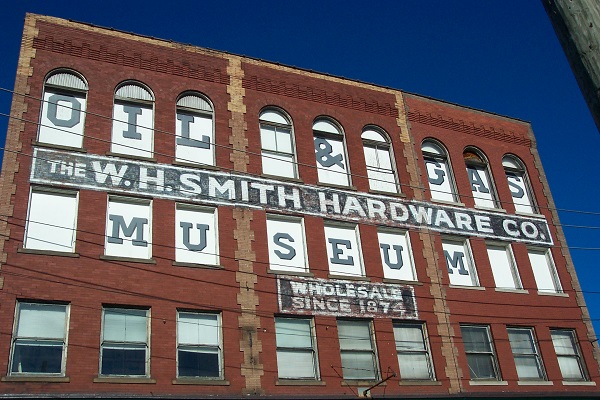
The Oil and Gas Museum in downtown Parkersburg, West Virginia. Photo by Bruce Wells.
“Both oil and natural gas were discovered in western Virginia by the first explorers in the mid-1700s. George Washington acquired 250 acres in what is now West Virginia because it contained an oil and gas spring. This was in 1771, making the father of our country the first petroleum industry speculator.”
The Oil and Gas Museum in downtown Parkersburg is housed in an historic building first built in 1874. It was burned and then rebuilt in 1900. Exterior exhibits include gas engines used at Burning Springs, circa 1910, and made in Parkersburg by the Spence Machine Company. There is an 1859 wooden oil tank from the Petroleum oilfield.
On May 9, 1863, Burning Springs oilfield was destroyed by Confederate raiders lead by General “Grumble” Jones — making it the first of many oil fields destroyed in war. Thanks to Director David McKain, a museum annex and visitors center has been added at the historic Rathbone Well at Burning Springs.
Royce J. and Caroline B. Watts Museum
The Royce J. and Caroline B. Watts Museum preserves and promotes the social, cultural, and technological history of West Virginia’s coal and petroleum industries through the collection, preservation, research, and exhibition of historical objects and archival materials.
Since the 1930s, West Virginia University has collected historical artifacts and archival materials from the mining and petroleum industries. Located at the university’s Mineral Resources Building, the Watts Museum includes thousands of objects representing distinct eras in the coal and petroleum industries.
Among the museum’s permanent collection are mining and drilling artifacts, including flame safety lamps, mine rescue equipment, canary cages, and model oil derricks.
Wisconsin
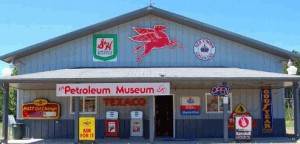
Ed Jacobsen’s expertise — and love for “the world of service stations” — resulted in Wisconsin’s Northwoods Petroleum Museum opening in 2006.
Ed Jacobsen, once a sales representative in the Chicago area for ENCO Oil Company (now ExxonMobil), once bought ailing service stations and returned them to health.
More than three decades later, retiring to his wife’s hometown of Three Lakes in the Northwoods region of upper Wisconsin, Ed missed “the world of service stations” so began visiting flea markets and garage sales. His memorabilia collection soon passed 2,700 items.
Wanting to share his collection — and needing a place to display it — Ed Jacobsen opened the Northwoods Petroleum Museum in 2006 on Highway 45 between Eagle River and Three Lakes. “I just love this stuff,” he says, noting his collection, which includes more than 50 gas pump globes, reflects a simpler time, when things were made to last.
Read more in the Wisconsin Petroleum Museum.
Wyoming
Campbell County Rockpile Museum

“Artifact of the Month” for March 2017 at the Rockpile Museum in in Gillette: The first air-cooled power plant in the United States.
Near where the railhead of the Burlington & Missouri Railroad arrived in Gillette, Wyoming, in 1891, the Campbell County Rockpile Museum opened in July 1974. “Ralph A. Kintz was the driving force behind the establishment of the museum, purchasing the land where the famous rock pile sits and then donating this property to the county in 1970,” explains museum Director Robert Henning.
“Our museum interprets the history of the Powder River Basin in Wyoming, including the history of oil, gas, and coal-bed methane,” Henning notes. “We have a wide variety of objects, photos, and archival materials related to the oil and gas industries.”
Among the collection is part of a control panel from the first air-cooled power plant in the United States. The 80 Megawatt, coal-fired plant at Wyodak went online in 1959, and went offline in 2014, according to Henning. It was demolished in 2015. “Prior to demolition, the staff at the Rockpile Museum was able to salvage part of the plant’s control panel,” he says. “Now in storage, the museum hopes to have this control panel on display in the near future to tell the story of electrical generation in the Powder River Basin.” The museum is at 900 W. 2nd Street and easily accessible via Exit 124 from Interstate-90.
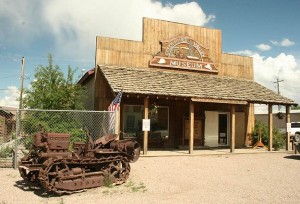
“When the oil industry first boomed, coal was used to supply power to the equipment,” explains a Green River Valley Museum exhibit.
The Green River Valley Museum, 206 N. Front Street, Big Piney, began in 1990 thanks to the Big Piney Centennial Committee.
The building at various times has served as a town hall, fire station and jail. “The original structure burned in 1948, leaving the charred metal jail cell exposed to the elements. Having nowhere else to hold prisoners, law enforcement officers continued to use the cell to hold them until they could be moved to a more suitable location. When the building was rebuilt, it was constructed around the jail cell. The jail cell today is one of the museum’s most popular attractions.”
In July 2000, the top section of an old production derrick was moved from the natural gas field between Big Piney and LaBarge to Norris Park at the East end of town – as a tribute to the contributions made by the oil and gas industry to the community. The derrick first came to the area in 1955 from Casper.
Hot Springs County Museum & Cultural Center
Located in Thermopolis, northwest of Casper, the Hot Springs County Museum & Cultural Center includes a Petroleum Building with an “Oil and Gas: Wyoming’s Black Gold” collection of industry exhibits.
The presence of oil in the region was known throughout the 19th century. The “Great Tar Spring”, ten miles southeast of Lander, was used by Native Americans to provide liniment for their horses. Mountain men and pioneers traveling across the country used it as axle grease for their wagons.
The present Hot Springs County Museum is the outgrowth of the Hot Springs County Pioneer Association Museum, which first opened its doors on July 4, 1941. Founded to preserve the history of the region’s settlers,
The Salt Creek Museum in Midwest exhibits the Salt Creek oilfields from 1889 to the present, including oilfield workers, their families, and the history of the area.
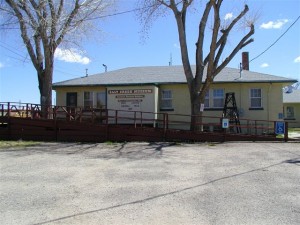
Pauline Schultz founded Wyoming’s Salt Creek Oil Museum in 1980. She received the National Humanities Medal in 2007.
Permanent exhibits include a doctor’s office that was in use from 1937 to 1993, school room, kitchen, barber shop, and household artifacts.
The museum holds a full set of Midwest Refining Company Books from 1920-1930, which detail the operations, according to Curator Pauline Schultz, who is writing a book about the Salt Creek Oil Field.
The Tate Geological Museum, founded in 1980 through a gift from Marion and Inez Tate, is located on the Casper College campus and a popular resource to the community: local schools and other groups come to the museum to add to their students learning experience. One of a small number of geology and paleontology museums in Wyoming, the Tate houses a collection of over 3,000 fossil and mineral specimens. Exhibits include a special core exhibit, “Wyoming Geologic Time.”
Wyoming State Historical Society
The Wyoming State Historical Society began in 1953 and provides direction and support for historical research and preservation in Wyoming. Made up of members across Wyoming, as well as from outside the borders, the society is open to any individual interested in history of Wyoming and the West.
Oil Museums are Energy Educators
Technology exhibits at petroleum museums offer insight to the nation’s energy heritage, which began with an 1859 oil discovery drilled 69.5 feet deep in Pennsylvania. Many museums are staffed with volunteer docents who worked in the industry and can teach young people about the complex modern business.
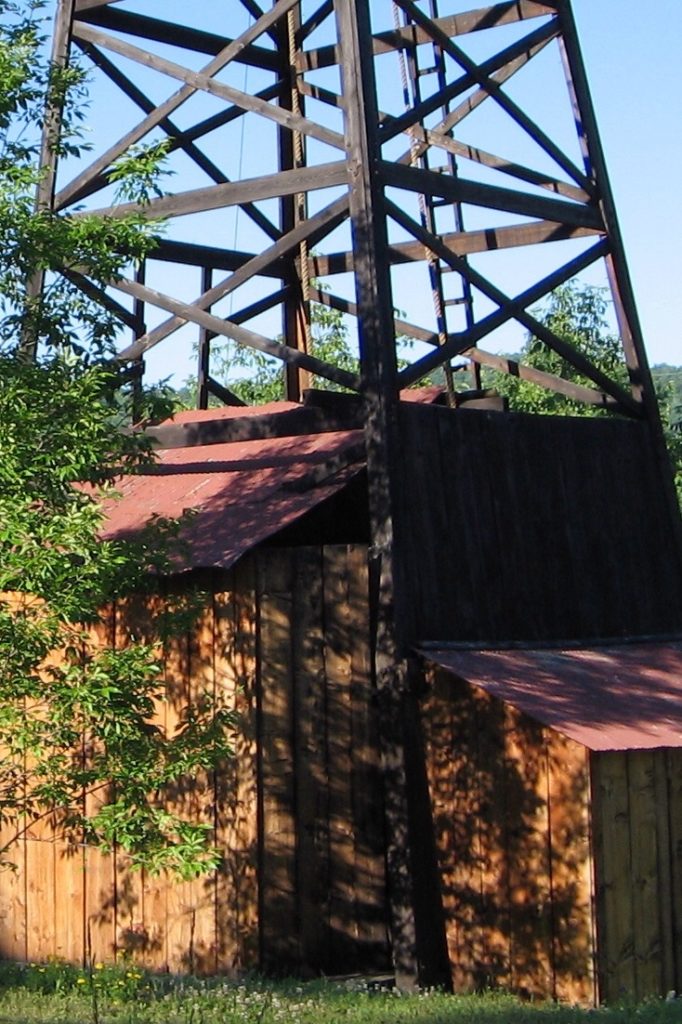
Removed in May 2020 over safety concerns, a replica circa 1870s standard cable-tool derrick helped educate visitors to the Penn-Brad Oil Museum in Custer City, Pennsylvania. Photo by Bruce Wells.
In addition to museums that often feature transportation (planes, trains, automobiles, and service stations), the 33 oil and natural gas producing states include many local museums with cable-tool derricks, drill bits, pump jacks, and equipment of all shapes and sizes.
Do you have artifacts. books, photographs, or petroleum-related memorabilia you want to preserve? Perhaps a museum can help. Learn more in Oil Families, where community museums preserve the many personal and professional stories of U.S. petroleum history.
_______________________________
Help the AOGHS energy education mission and help preserve U.S. petroleum history — become a supporting member. Want to add a museum or update one? Know of other exhibits? Please contact the society.
© Copyright 2003-2023 by Bruce A. Wells, American Oil & Gas Historical Society (AOGHS). All rights reserved.


